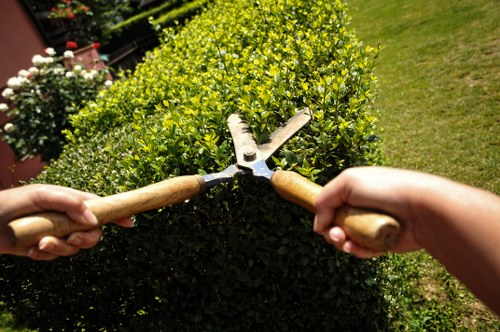Mastering Hedge Trimming in Gardeners Gardening
Introduction to Hedge Trimming

Hedge trimming is a fundamental aspect of garden maintenance that ensures the health and aesthetic appeal of your outdoor space. Whether you're a seasoned gardener or a beginner, understanding the techniques and tools involved in hedge trimming can make a significant difference in the overall look of your garden.
Regular trimming promotes plant health, prevents diseases, and encourages robust growth. It also helps maintain the desired shape and size of your hedges, contributing to a well-organized and visually pleasing garden layout.
In this article, we'll delve into the essentials of hedge trimming, including the best practices, tools needed, and common mistakes to avoid. By the end, you'll be equipped with the knowledge to keep your hedges looking their best all year round.
Why Hedge Trimming Matters

Hedge trimming is more than just an aesthetic exercise; it's crucial for the long-term health of your plants. Proper trimming:
- Encourages Bushier Growth: Cutting back the branches stimulates the plant to grow more densely, giving your hedges a fuller appearance.
- Prevents Overgrowth: Regular maintenance keeps your hedges from becoming unruly and encroaching on other parts of your garden.
- Reduces Disease Risk: Removing dead or diseased branches prevents the spread of infections and pests.
Moreover, well-trimmed hedges can enhance your property's value by contributing to a neat and well-maintained exterior.
Neglecting hedge trimming can lead to a variety of issues, including weak structures, increased susceptibility to diseases, and an untidy appearance that detracts from your garden's overall charm.
Essential Tools for Hedge Trimming

Having the right tools is essential for effective hedge trimming. Here's a list of must-have equipment:
- Pruning Shears: Ideal for trimming small branches and shaping your hedges with precision.
- Hedge Trimmers: Available in manual or electric versions, these are perfect for cutting larger sections of your hedges efficiently.
- Loppers: Suitable for thicker branches that are too robust for shears but not large enough to require saws.
- Protective Gear: Safety glasses, gloves, and sturdy footwear protect you while you work.
- Stepladder: Helps you reach higher sections of your hedges safely.
Investing in quality tools not only makes the trimming process easier but also ensures that your hedges receive clean cuts, which is vital for preventing disease and promoting healthy growth.
Step-by-Step Hedge Trimming Guide

1. Assess Your Hedges
Before you start trimming, take a moment to assess the current state of your hedges. Look for any dead or diseased branches that need immediate removal.
2. Choose the Right Time
The best time to trim hedges is during late spring or early summer when plants are actively growing. Avoid extreme weather conditions, such as during heavy rain or drought.
3. Start with the Basics
Begin by removing any dead or damaged branches. This helps improve air circulation and reduces the risk of disease spreading.
Tip:
Use sharp, clean tools to make precise cuts, which are crucial for the plant’s recovery.
Trimming Techniques for Different Hedge Types

Different types of hedges require specific trimming techniques to maintain their shape and health.
Formal Hedges
Formal hedges, such as boxwood, require meticulous trimming to maintain their geometric shapes. Use string lines or guides to ensure straight and even cuts.
- Shape Maintenance: Trim the sides and top uniformly to achieve a clean, structured look.
- Regular Pruning: Conduct trimming sessions multiple times a year to keep the hedge in perfect condition.
Informal Hedges
Informal hedges, like yew or privet, offer more flexibility in shaping. They can be trimmed into natural forms or left to grow freely for a more relaxed appearance.
Key Points:
- Less Precision Needed: Focus on overall density rather than specific shapes.
- Encourage Natural Growth: Trim selectively to promote healthy, bushy growth without over-constraining the plant.
Understanding the specific needs of your hedge type ensures that you apply the correct trimming techniques, leading to healthier and more attractive plants.
Common Mistakes to Avoid in Hedge Trimming
Avoiding common pitfalls can significantly improve your hedge trimming results.
1. Over-Trimming
Removing too much foliage at once can stress the plant, making it susceptible to diseases and pests.
2. Ignoring Plant Health
Failing to remove diseased or dead branches can lead to the spread of infections throughout the hedge.
3. Using Dull Tools
Dull blades cause ragged cuts, which can hinder the plant's healing process and invite disease.
Avoid These Mistakes:
- Trim Gradually: Make small cuts over several sessions rather than attempting drastic shape changes at once.
- Maintain Tool Sharpness: Regularly sharpen your tools to ensure clean cuts.
- Monitor Plant Health: Keep an eye out for signs of stress or disease and act promptly.
Seasonal Hedge Trimming Tips
Different seasons require specific approaches to hedge trimming to optimize plant health and aesthetics.
Spring Trimming
Spring is ideal for shaping hedges and removing any winter damage. It's also a good time to apply fertilizers to encourage new growth.
Summer Maintenance
During summer, focus on light trimming to control growth and prevent the hedge from becoming too dense.
Autumn Care
Autumn trimming helps prepare your hedges for the winter months by removing weak branches and reducing the plant's energy consumption.
Winter Pruning
While major trimming should be avoided in winter, you can perform minimal pruning to tidy up any last-minute growth.
Seasonal Checklist:
- Inspect for damage and disease.
- Shape and size control based on growth patterns.
- Apply appropriate treatments like fertilizers or pest control agents.
- Prepare tools and equipment for the upcoming season.
Maintaining Your Hedge Trimming Tools
Proper maintenance of your tools ensures longevity and effectiveness.
Cleaning:
After each use, clean your tools thoroughly to remove sap, dirt, and any plant debris. This prevents rust and maintains hygiene, especially important if you're working with diseased plants.
Sharpening:
Regularly sharpen blades to ensure clean cuts. Sharp tools reduce the effort required for trimming and minimize damage to the plants.
Storage:
Store your tools in a dry, secure place to prevent rusting and damage. Using protective covers or cases can extend their lifespan.
Maintenance Tips:
- Use a sharpening stone: For manual tools, a sharpening stone can keep blades in top condition.
- Oil the blades: Apply a light coat of oil to metal parts to prevent rust.
- Check for damage: Regularly inspect tools for any signs of wear and replace parts as needed.
Eco-Friendly Hedge Trimming Practices
Adopting sustainable trimming practices benefits both your garden and the environment.
Composting Clippings
Instead of disposing of trimmings, compost them to create nutrient-rich soil for your garden. This reduces waste and promotes soil health.
Using Electric Tools
Electric or battery-powered tools are more environmentally friendly compared to gas-powered ones. They produce less noise and reduce carbon emissions.
Natural Pest Control
Encourage natural predators like birds and beneficial insects to manage pest populations instead of relying on chemical treatments.
Benefits of Eco-Friendly Practices:
- Reduces Environmental Impact: Minimizes pollution and conserves natural resources.
- Promotes Sustainable Gardening: Enhances the long-term health and productivity of your garden.
- Cost-Effective: Composting and natural pest control methods can save money on fertilizers and pesticides.
Advanced Hedge Trimming Techniques
For those looking to elevate their trimming skills, consider these advanced techniques:
Shearing
Shearing involves using specialized tools to create precise shapes and patterns in your hedges. It's commonly used for formal gardens to achieve uniformity.
Thinning
Thinning removes specific branches to allow light and air to penetrate the hedge, promoting healthier growth without significantly altering its shape.
Deadheading
Although more common in flowering plants, deadheading can be applied to hedges to remove spent flowers and encourage continuous blooming.
Implementing Advanced Techniques:
- Plan your desired shape or pattern before starting.
- Use the appropriate tools for each technique to ensure precision.
- Take breaks to assess your progress and make adjustments as needed.
Choosing the Right Hedge for Your Garden
Selecting the appropriate hedge plant is the first step in effective hedge trimming and overall garden success.
Popular Hedge Plants
- Boxwood: Ideal for formal hedges due to its dense foliage and ability to be shaped precisely.
- Privet: Fast-growing and versatile, suitable for both formal and informal gardens.
- Yew: Evergreen with a graceful appearance, perfect for creating privacy screens.
- Holly: Adds color and texture with its vibrant berries and glossy leaves.
Factors to Consider:
- Climate Suitability: Ensure the hedge plant thrives in your local climate conditions.
- Growth Rate: Choose a plant that matches your desired maintenance level and timeline.
- Maintenance Requirements: Different plants require varying levels of care and trimming frequency.
- Purpose: Whether for privacy, decoration, or windbreaks, select a plant that meets your specific needs.
By carefully selecting the right hedge plant, you can ensure easier maintenance and a more attractive garden design.
Additional Tips:
- Research the mature size of the plant to avoid overcrowding.
- Consider the foliage color and texture to complement your garden's aesthetic.
- Check for any pest or disease susceptibilities associated with the plant.
Hedge Trimming Safety Tips
Safety should always be a priority when trimming hedges to prevent accidents and injuries.
Personal Protective Equipment (PPE)
Always wear appropriate PPE, including:
- Gloves: Protect your hands from sharp tools and plant irritants.
- Safety Glasses: Shield your eyes from debris and accidental cuts.
- Sturdy Footwear: Prevent slips and protect your feet from dropped tools.
- Long Sleeves: Guard against scratches and sun exposure.
Tool Safety
Handle tools with care to prevent mishaps:
- Inspect Tools: Check for damage or wear before use.
- Proper Handling: Use tools according to manufacturer instructions.
- Storage: Keep tools securely stored when not in use to prevent accidents.
Working at Heights
If your hedges are tall, use a stable stepladder or ladder to reach higher areas safely. Avoid overreaching, and ensure the ladder is on a flat surface.
Emergency Preparedness:
- Know basic first aid procedures.
- Have a phone nearby in case of emergencies.
- Work with a partner when handling particularly large or dangerous tasks.
Cost-Effective Hedge Trimming Solutions
Maintaining your hedges doesn't have to break the bank. Here are some tips for cost-effective trimming:
DIY Trimming
By performing hedge trimming yourself, you can save on labor costs. Invest in quality tools and educate yourself on proper techniques to achieve professional results.
Tool Maintenance
Properly maintained tools last longer and perform better, reducing the need for frequent replacements.
Seasonal Deals
Look out for discounts on gardening tools and supplies during seasonal sales to equip yourself without overspending.
Budget Tips:
- Plan and Schedule: Regular maintenance prevents the need for extensive trimming sessions, saving time and money.
- Recycle Clippings: Use trimmings for compost or mulch rather than purchasing additional materials.
- Share Resources: Consider tool-sharing with neighbors or community gardens to reduce individual costs.
Professional Hedge Trimming Services
If DIY trimming isn't feasible, hiring professionals can ensure your hedges are maintained to the highest standards.
Benefits of Professional Services
- Expertise: Professionals have the knowledge and experience to handle all hedge types effectively.
- Efficiency: They can complete trimming tasks quickly and accurately, saving you time.
- Advanced Equipment: Access to high-quality tools and machinery that may be costly to purchase individually.
Choosing the Right Service:
- Reputation: Look for companies with positive reviews and a track record of quality work.
- Services Offered: Ensure they provide the specific trimming services you need.
- Pricing: Compare quotes to find a service that fits your budget without compromising quality.
Delegating hedge trimming to professionals allows you to enjoy a well-maintained garden without the hassle of doing it yourself.
When to Hire Professionals:
- When handling large or complex hedges.
- If you lack the time or physical ability to perform trimming.
- For seasonal or periodic maintenance contracts.
Innovations in Hedge Trimming
Technological advancements have revolutionized hedge trimming, making the process more efficient and accessible.
Automated Trimmers
Robotic hedge trimmers can autonomously maintain hedges, offering a hands-free solution for regular trimming needs.
Smart Tools
Connected tools with sensors and smart features provide real-time feedback on trimming techniques, enhancing precision and safety.
Eco-Friendly Innovations
New tools powered by renewable energy sources reduce the environmental impact of hedge trimming.
Future Trends:
- AI Integration: Artificial intelligence can assist in planning trimming patterns and schedules based on plant growth.
- Enhanced Ergonomics: Tools designed for better comfort and reduced fatigue during extended use.
- Sustainable Materials: Development of durable, eco-friendly materials for tools and equipment.
Hedge Trimming and Garden Design
Hedge trimming plays a vital role in the overall design and functionality of your garden.
Creating Structure
Well-trimmed hedges provide structure to your garden, defining different areas and pathways. They can act as natural boundaries, enhancing the layout and flow of your outdoor space.
Enhancing Visual Appeal
By maintaining the shape and size of your hedges, you add clean lines and symmetry, contributing to a polished and inviting garden environment.
Functional Benefits
Trimming hedges can improve privacy, act as windbreaks, and even serve as noise barriers, making your garden more comfortable and enjoyable.
Design Tips:
- Coordinate hedge shapes with other garden elements like benches, fountains, and flower beds.
- Use varying hedge heights to create depth and visual interest.
- Incorporate flowering or fruiting hedges for added color and texture.
Conclusion
Hedge trimming is an essential practice for maintaining the beauty and health of your garden. By understanding the importance of regular trimming, investing in the right tools, and applying proper techniques, you can ensure your hedges remain vibrant and well-shaped.
Whether you choose to tackle the task yourself or hire professional services, prioritizing hedge maintenance will enhance your garden's aesthetic appeal and contribute to a thriving outdoor space. Embrace the art of hedge trimming and enjoy the rewards of a meticulously maintained garden.
Get Started Today
If you're ready to elevate your garden's appearance with expert hedge trimming, contact us today or book your service now. Our team of professionals is here to help you achieve the garden of your dreams.



